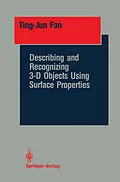Surface properties play a very important role in many perception tasks. Object recognition, navigation, and inspection use surface properties ex tensively. Characterizing surfaces at different scales in given data is often the first and possibly the most important step. Most early research in ma chine perception relied on only very coarse characterization of surfaces. In the last few years, surface characterization has been receiving due attention. Dr. T. J. Fan is one of the very few researchers who designed and im plemented a complete system for object recognition. He studied issues re lated to characterization of surfaces in the context of object recognition, and then uses the features thus developed for recognizing objects. He uses a multi-view representation of 3-D objects for recognition, and he devel ops techniques for the segmentation of range images to obtain features for recognition. His matching approach also allows him to recognize objects from their partial views in the presence of other occluding objects. The efficacy of his approach is demonstrated in many examples.
Inhalt
1 Introduction.- 1.1 The Input.- 1.2 Issues in Shape Description.- 1.2.1 Criteria for shape description.- 1.2.2 Choosing segmented surface descriptions.- 1.3 Issues of Recognition.- 1.3.1 Description of models.- 1.3.2 Matching primitives and algorithms.- 1.4 Questions for the Research.- 1.5 The Contribution of the Research.- 1.6 Organization of the Book.- 2 Survey of Previous Work.- 2.1 Survey of Shape Descriptions.- 2.1.1 Volume descriptions.- 2.1.2 Curve/line descriptions.- 2.1.3 Surface descriptions.- 2.1.4 Summary.- 2.2 Survey of Recognition Systems.- 2.2.1 3DPO.- 2.2.2 Nevatia and Binford.- 2.2.3 ACRONYM.- 2.2.4 Extended Gaussian Image (EGI).- 2.2.5 Oshima and Shirai.- 2.2.6 Grimson and Lozano-Pérez.- 2.2.7 Faugeras and Hebert.- 2.2.8 Bhanu.- 2.2.9 Ikeuchi.- 2.2.10 Summary.- 3 Surface Segmentation and Description.- 3.1 Curvature Properties and Surface Discontinuities.- 3.2 Detecting Surface Features.- 3.2.1 Method 1: using directional curvatures and scale-space tracking.- 3.2.2 Method 2: using principal curvatures at a single scale.- 3.2.3 Method 3: using anisotropic filtering.- 3.3 Space Grouping.- 3.4 Spatial Linking.- 3.5 Segmentation into Surface Patches.- 3.6 Surface Fitting.- 3.7 Object Inference.- 3.7.1 Labeling boundaries.- 3.7.2 Occlusion and connectivity.- 3.7.3 Inferring and describing objects.- 3.8 Representing Objects by Attributed Graphs.- 3.8.1 Node attributes.- 3.8.2 Link attributes.- 4 Object Recognition.- 4.1 Representation of Models.- 4.2 Overview of the Matching Process.- 4.3 Module 1: Screener.- 4.4 Module 2: Graph Matcher.- 4.4.1 Compatibility between nodes of the model view and scene graph.- 4.4.2 Compatibility between two pairs of matching nodes.- 4.4.3 Computing the geometric transform.- 4.4.4 Modifications based on the geometric transform.- 4.4.5 Measuring the goodness of a match.- 4.5 Module 3: Analyzer.- 4.5.1 Splitting objects.- 4.5.2 Merging objects.- 4.6 Summary.- 5 Experimental Results.- 5.1 The Models.- 5.2 A Detailed Case Study.- 5.2.1 Search nodes expanded in recognition.- 5.3 Results for Other Scenes.- 5.4 Parallel Versus Sequential Search.- 5.5 Unknown Objects.- 5.6 Occlusion.- 6 Discussion and Conclusion.- 6.1 Discussion.- 6.1.1 Problems of segmentation.- 6.1.2 Problems of approximation.- 6.2 Contribution.- 6.3 Future Research.- 6.3.1 From surface to volume.- 6.3.2 Applications.- A Directional Curvatures.- B Surface Curvature.- C Approximation by Quadric Surfaces.
